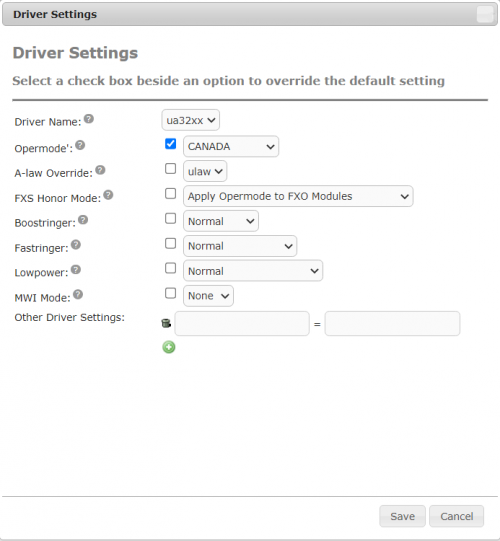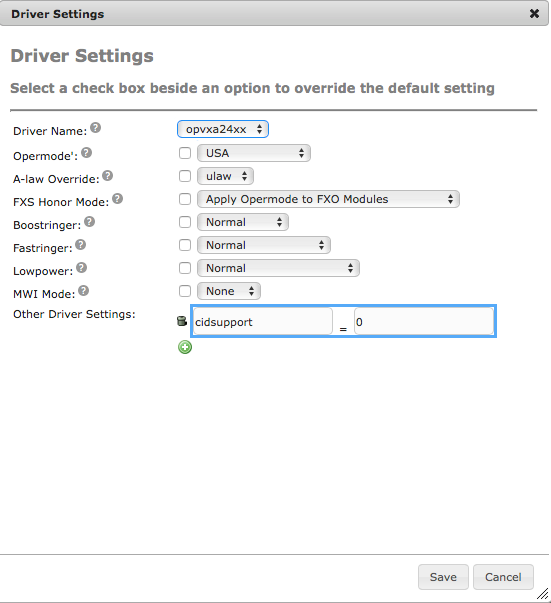PSTN Cards - Settings
Settings that apply to all the cards and spans can be configured via the Settings section located at the top right hand corner of the page.

Global Settings
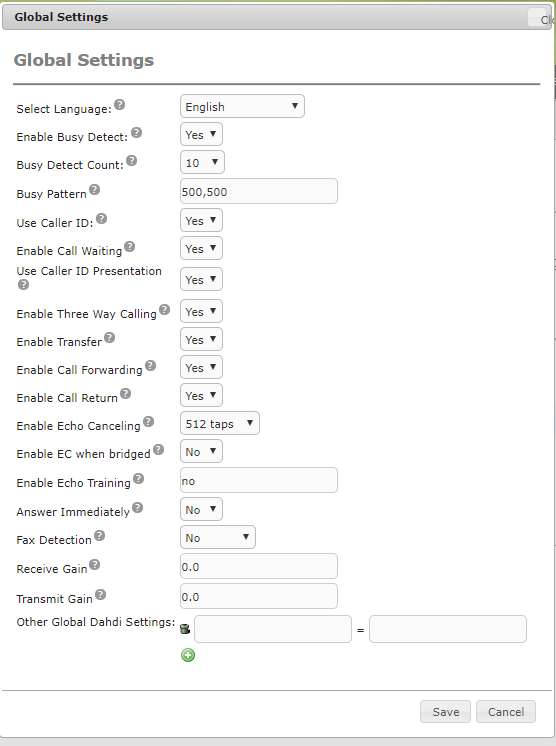
|
Field
|
Default Value
|
Description
|
|---|---|---|
| Select Language | English | Specify the language. |
| Enable Busy Detect | Yes | On trunk interfaces (FXS) and E&M interfaces (E&M, Wink, Feature Group D etc.) it can be useful to perform busy detection either in an effort to detect hangup or for detecting busies. This enables listening for the beep-beep busy pattern. |
| Busy Detect Count | 10 | If busydetect is enabled, it is also possible to specify how many busy tones to wait for before hanging up. The default is 3, but is might be safer to set for 6 or even 8. mind that the higher the number, the more time that will be needed to hangup a channel, but lowers the probability that you will get random hangups. |
| Busy Pattern | 500,500 | If busydetect is enabled, it is also possible to specify the cadence of your busy signal. In many countries, it is 500 msec on, 500 msec off. Without busypattern specified, any regular sound-silence pattern that repeats busycount times is accepted as a busy signal. If you specify busypattern, the length of the sound (tone) and silence is checked further reducing the chance of a false positive. |
| Use Caller ID | Yes | Specify whether to use caller ID. |
| Enable Call Waiting | Yes | Specify whether to enable call waiting on internal extensions. With this set to yes, busy extensions will hear the call-waiting tone, and can use hook-flash to switch between callers. The dial() app will not return the BUSY result for extensions. |
| Use Caller ID Presentation | Yes | Specify whether to use the caller ID presentation for outgoing calls that the calling switch is sending |
| Enable Three Way Calling | Yes | Support three way calling |
| Enable Transfer | Yes |
For FXS ports (either direct analog or over T1/E1): Support hook-flash call transfer (requires three way calling enabled), also enables call parking (overrides the canpark parameter)
For digital ports using ISDN PRI protocols: Support switch-side transfer (called 2BCT, RLT or other names). This setting must be enabled on both ports involved, and the facilityenable setting must also be enabled to allow sending the transfer to the ISDN switch, since it is sent in a FACILITY message |
| Enable Call Forwarding | Yes | Support call forward variable |
| Enable Call Return | Yes | Support Call Return (*69, if your dialplan does not catch this first) |
| Enable Echo Canceling | 512 taps | Enable echo cancellation is on by default, and set to 512 taps. Can be disabled (set to 'No') or other settings for greater or less processing. |
| Enable EC when bridged | No | Generally, it is not necessary (and undesirable) to echo cancel when the circuit path is entrely TDM. You may, however, change this behavior by enabling the echo canceler during pure TDM bridging. |
| Enable Echo Training | No |
In some cases, the echo canceller does not train quickly enough and there is echo at the beginning of a call. Enabling echo training will cause DAHDI to briefly mute the channel, send an impulse, and use the impulse response to pre-train the echo canceller so it can start out with a much closer idea of the actual echo. Value may be yes, no, or a number of milliseconds to delay before training, default is 400. WARNING: In some cases this option can make echo worse! If you are trying to debug an echo problem, it is worth checking to see if your echo is better with the option set to yes or no. Use whatever setting that gives the best result. |
| Answer Immediately | No | Specify whether the channel should be answered immediately or if the simple switch should provide dialtone, read digits, etc. Note: if yes the dialplan execution will always start at extension 's' priority 1 regardless of the dialed number. |
| Fax Detection | No | Enable fax detection |
| Receive Gain | 0.0 | The values are in decibels (db). Positive number increases volume level, negative number decreases volume level. |
| Transmit Gain | 0.0 | The values are in decibels (db). Positive number increases volume level, negative number decreases volume level. |
| Other Global Dahdi Settings | Enter the dahdi parameter in the first box and the value in the second box. |
System Settings
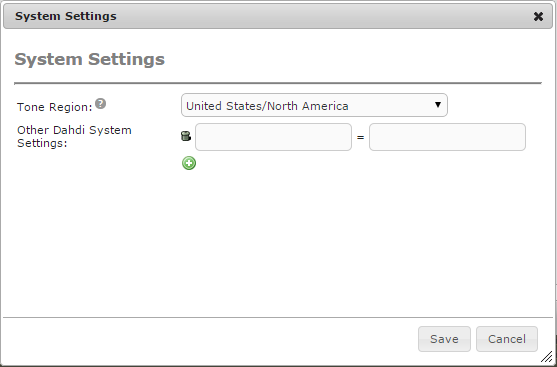
|
Field
|
Description
|
|---|---|
| Tone Region | Choose your country or nearest neighbouring country for default tones (e.g. dialtone, ringtone, busytone etc.) |
| Other Dahdi System Settings | Enter the dahdi parameter in the first box and the value in the second box. |
Driver Settings
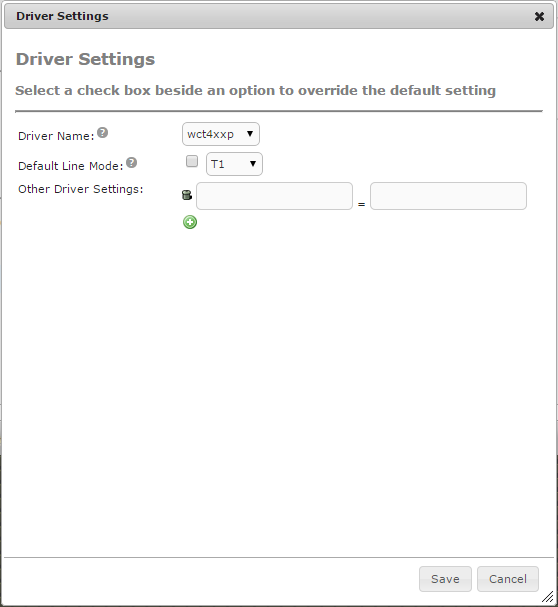
|
Field
|
Description
|
|---|---|
| Driver Name | Specify the kernel module used by the installed analog hardware. |
| Default Line Mode |
The recommended way to set line mode on your Digium 1-, 2-, 4-port (span) digital telephony cards is to set the jumper(s) on the card for either T1 or E1 mode for each span on the card. With the jumper OFF, the span is ready for T1 mode; with the jumper ON, the span is ready for E1 mode. (See Install T1/E1 Interface card on UCX50 for details.) However, sometimes if a card is installed in a server without first setting the jumper(s) correctly, and it is inconvenient to remove the card from the server to access the jumper(s), then the "default_linemode" option can be passed when the card's device driver is loaded. |
| Other Driver Settings | Enter the dahdi parameter in the first box and the value in the second box. |



